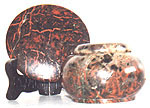

The planetary stone for Scorpio is serpentine: the illustration in the Star Crystals section of the book (pages 76 and108) of a pale green serpentine is not, strictly speaking, the ideal form of this mineral for this Sign. Here is a near-perfect example...
Due to space restrictions in the book, our ethical stance had to be omitted from the final product. We have therefore posted it here instead.
The blossoming of interest in crystals and other minerals has brought a unique beauty into our lives. No-one can deny their power to fascinate and attract, and the tide of popularity shows no sign of turning.
Such treasures are frequently rare and often difficult to obtain, and this is reflected in the prices we pay. But there are other factors, vital factors, which are not always included in the asking price...
Adulteration
(What you see is not what you get!)
Over the millennia sharp-practising miners and merchants have exploited a bewildering array of techniques to transform minerals into something more "desirable" - i.e. expensive! Simply dyeing specimens a darker or different colour is probably the favourite trick (Turquoise and Chalcedony are particularly vulnerable to dye), closely followed by various forms of heat treatment (Citrine, for example may be produced from either Smoky Quartz or Amethyst). Anyone wishing to work closely with Nature must be extremely careful about these artificially modified minerals. Indeed, some techniques deserve general caution as the alterations are temporary and the stones degenerate horribly - sometimes within a very short space of time.
Despoliation
(Where does it come from?)
In many instances precious stones have been mined for millennia with practically negligible environmental impact, and some contemporary techniques of mining are largely overlooked by native flora and fauna. On the other hand, however, some environmentally sensitive countries have great riches in their rocks, but when financial pressures are applied, inadequate care may be taken to preserve the unique habitat of threatened species above ground. Some methods of crystal extraction have been compared to ripping out the Earth Mother's teeth - without anaesthetic.
Exploitation
(Where does your money go?)
Many minerals can be collected quite easily (Amber, Jet, Peridot and Flint, for example, can simply be picked up from appropriate beaches), and even small scale trade in these minerals can supplement otherwise very low incomes. Others are often wrested from the earth in difficult and dangerous mining operations. Third World native labour is routinely cruelly exploited by First World companies with a vested interest in keeping the cost of their products low - regardless of the high cost in terms of human misery.
Manipulation
(The market price is rigged by suppliers)
The price of Oil has long been carefully controlled by a cartel of governments of Middle Eastern countries within whose political boundaries the mineral is plentiful. Other minerals (a notorious example being Diamond) have also had their prices determined by monopolistic suppliers. Many of the treasures of the Earth are held in the hands of a few economically powerful men (and they are mostly men, not women), who deliberately starve the market so that people will pay extortionate prices.
Slaughter
(Who paid the ultimate price?)
Many prized components of jewellery are derived from once-living creatures; Amber, Jet, and other Fossils are prime examples. But some organic gems form a special category where their harvesting has been the direct cause of death of the organism from which they came - for example Ivory, Pearl, and Coral. Like the use of live animals in cosmetics testing, the trade in these ornamental minerals is coming under sustained and mounting attack. It is a matter of individual conscience: direct involvement in the trade means culpability in the killing. There is however a small loophole for those resolute in possessing them: trade has been going on for so long that second-hand specimens are not hard to find (it can even be argued that their employment for genuine, beneficial and positive ends may help to balance the greed and ignorance that caused the creature's death in the first place).
In conclusion
There is an extreme point of view which argues that every crystal deserves to be simply left where it grows, neither mined, polished, nor sold (nor, indeed, even discovered). Blatantly raping the Earth of her treasures is equally extreme, of course, but it too has its protagonists, and both opinions are stoutly defended despite common sense objections.
It is abundantly clear that excessive exploitation inevitably deprives future generations of what could be a legacy of pristine marvels. In this respect, we anticipate that on-site museums revealing spectacular geological formations in caverns and excavations, will become increasingly significant tourist attractions. Certainly, denying ourselves access to crystals and other stones completely would curtail what has been a long tradition of mankind's spiritual development. We earnestly hope that in some small way - perhaps even in spite of itself - this book might stand to influence people to act responsibly with what are finite and incalculably precious resources.
Ken and Joules Taylor
Back to Crystals...
Text © Ken Taylor 2004 - 2013